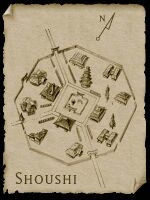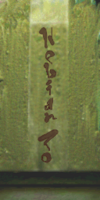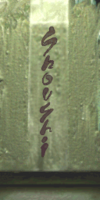| |||||||||||||||
History
On Ispar
Founding
The history of the Sho is intertwined with their mythology. For more information on the Sho creation story, see Religions and Beliefs. The legendary founder of the Sho Nation was Shou-Jen Rian. According to their beliefs, after dishonoring the Dragon of Power, Shou-Jen Rian and his kinsmen were driven west and south by the Dragon, who burned their crops and destroyed their villages.[1][2] The people were driven southwest for years, all the way to the sea.[1][2] There, the Shou-Jen family established a kingdom and named it after the Dragon (Ryujii) to placate the Elder.[3] However, six families instead sailed across the sea and founded their own kingdoms upon islands named after the Firebird (Iiwah) and the Unicorn (Chiran-tou).[1][2][3]
While the dates of the founding of the Sho Nation are unknown, we can some assumptions. The first is that the Ryu Jou Gai, the Order of the Dragon Temple, was founded after the founding of Ryujii since the Ryu Jou Gai is based at the Dragon Temple in the Sho homelands.[4] In Leafcull, 10 PY (1286 RC) the Ryu Jou Gai was said to have been founded over one thousand years ago, giving us an approximate date of 286 RC for the Order's founding. Thus, one can assume that the events of the founding of the Sho Nation took place at some point prior to that.
Given that this is a fantasy setting, it is entirely possible that the Sho creation story and their Elder spirits are real beings and the story of Shou-Jen Rian is true. However, if interpreting their mythology from a more secular point of view, it is possible that the Dragon destroying their crops and home and driving them to the sea is a metaphor for a stronger nation expanding their territory by claiming the old Sho homelands. If the Sho Nation was founded some time prior to 286 RC, the Roulean Empire could certainly be the rival nation. Another idea, presented on Warcry's Crossroads of Dereth's Sho introduction article is that the Dragon was a metaphor for volcanic activity.
Three Kingdoms
For centuries after the founding of the three kingdoms warlords feuded amongst themselves, mostly in the name of one of the Elder spirits or another.[3]
Over a thousand years ago (286 RC or earlier), the Ryu Jou Gai was founded.[4]
Around 800 years ago (approximately 486 RC) Jojii received a vision from Unicorn of Grace on how to reach Paradise by following four primary precepts: Humility, Discipline, Detachment and Compassion.[3]
[5] This new religion, called Jojiism, would gradually become the guiding school of thought for the Sho.[3] For more on Jojiism, see Religions and Beliefs.
No more than 500 years ago (approximately 793 RC or later) the Tanada Clan of Nanjou Shou-Jen arose in the midst of a minor territorial war between the warlords Fansin Hanu and Kosu Jainan.[6]
300 years ago (986 RC) a split occured in the Chiran Jou Gai, the Order of the Unicorn Temple. While the Order focused on healing magic, the new group, the Chiran Jishui Dan or The Ranks of the Unicorn’s Battle focused instead on battle magic.[4]
Unification and the Kou Dynasty
(Source ref for later)[7]
On Dereth
Rulers
| Name | Bloodline | Rank/Title | Years of reign | Notes |
| Shou-Jen Rian | ?? | ?? | ?? | Legendary founder of the Sho Nation |
|
| ||||
| Kou | ?? | Emperor | 1086 RC - ?? | Emperor who united the Sho Nation under one banner. |
|
| ||||
| Kou-an | Granddaughter of Kou | Empress | 1176 RC - ?? | Regarded as very wise. Sent 1000 emissaries to other nations of Ispar. |
|
| ||||
| Sources: Sho Introduction, The Glorious Reign of Empress Kou-an,The Shou-Jen and the Founding of Ryuujii Version 1 and Version 2 & other sources cited on the Timeline of Ispar. | ||||
Culture
Religions and Beliefs
Customs and Traditions
From Winter Festivals from Ispar:
- South and west of the Naqut, over the tall mountains, the Sho lands brace as both the water and the air grow cold. The weather can shift with little warning from clear skies to torrential, wind-driven rains that leave towns flooded and in ruins, and on the coldest days, snow falls from the sky and blankets the ground in a thin layer of white. Some say the first pure snow of the year is the funeral ashes of the Wind Dragon, slain so long ago by Shou-Jen.
During this time, the Imperial Capital traditionally threw open its gates, and the last of the fresh harvest was brought forth, after the bulk had been pickled, smoked, or dried for the rest of the winter. But seeing that many used the time purely for culinary excess, Emperor Kou, the founder of the Kou Dynasty, saw that wisdom's touch was needed. Believing that the Four Stones of discipline, compassion, detachment, and humility were the true foods of the soul, he decreed the celebrations must ultimately honor the Elder Spirits and the teachings of Jojii, for without truth, even the best of harvests means very little. He also decreed that the temples must release their students and acolytes during the celebration, not only to reunite families but also to permit them to glean wisdom from their students' studies.
So the temples and monasteries across the land now release their students and acolytes, who travel homeward amidst the first snowflakes to meet their families, share some of their hard-won knowledge, and enjoy days of feasting. Travelers began carrying lanterns and torches, and the waiting towns would welcome them home with a myriad of bright paper lanterns. Children too young for the monasteries especially seem to enjoy the season, when their elder siblings return home and all can engage in the festivities together. Some towns have gone so far as to host parades, celebrating the return of loved ones and another year of abundance. Thus, the Festival of Lights, starting at first as a gluttonous spectacle, grew moderated by wisdom, and came to be the celebration it now is.
The Sho lands are bright and bustling places during this season, with small groups of torchbearers walking the roads. For the Sho, the Festival of Lights is a time to accomplish great things, and reach out to assist one's neighbors.
Real World Basis
The Sho culture is based on East Asian cultures, in particular the cultures of Japan and China.
Numerous names for Sho places and items are Japanese or Chinese. The word Ono is Japanese for "axe".[8] The word Yoroi comes from Ō-Yoroi, Japanese for "great armor".[9] The name of the forest town of Lin most likely comes from the Chinese name Lin, meaning "forest".[10]
The Sho naming system of having the surname first and the given name last is based on the naming traditions of China,[11] Japan,[12] Korea,[13] and Vietnam.[14]
The three elder spirits have basis in reality as well. Ryujii, the Dragon of Power is most likely based on the Japanese dragon god named Ryūjin. Chiran-Tou, the Unicorn of Grace, is most likely based on the Japanese and Korean Kirin, derived from the Chinese Qilin, sometimes called the Chinese unicorn. Iiwah, the Firebird of Splendor, may be based on the Fenghuang, the Chinese phoenix, although the names are not similar.
The Four Stones of Jojii are most likely based on the Taoist Three Jewels, which could be interpreted as compassion, humility, and frugality or simplicity. The four stones of Jojii change frugality or simplicity to detachment from worldly things, and add the fourth stone of discipline.
The four houses of the Tanada Clan of Nanjou Shou-Jen, Air, Earth, Water, and Fire, correspond to four of the five elements of Japanese philosophy and the four great elements of Buddhism.
Texts
![]() Firebird's Splendor (Text)
Firebird's Splendor (Text)![]() Jojii Zhen Gai Comments on the Teachings of Jojii
Jojii Zhen Gai Comments on the Teachings of Jojii![]() Ken-Gou and the Curse of Attachment
Ken-Gou and the Curse of Attachment![]() Letter From Home (Sho)
Letter From Home (Sho)![]() Loka Jii Learns to Hunt
Loka Jii Learns to Hunt![]() On the Four Stones and Three Elders
On the Four Stones and Three Elders![]() Reflections of a Portal
Reflections of a Portal![]() Scrawled Note (Jojii)
Scrawled Note (Jojii)![]() Stone of the Firebird (Text)
Stone of the Firebird (Text)![]() The Collected Writings of Jhong Mi
The Collected Writings of Jhong Mi![]() The Emperor's Blade
The Emperor's Blade![]() The Journal of Nandesu Ka
The Journal of Nandesu Ka![]() The Rise and Fall of the Tanada
The Rise and Fall of the Tanada![]() The Story of Ben Ten and Yanshi
The Story of Ben Ten and Yanshi![]() The Story of Koji and the Dragon of Power
The Story of Koji and the Dragon of Power![]() The Story of Koji's Sword
The Story of Koji's Sword![]() Unicorn's Grace (Text)
Unicorn's Grace (Text)
Internet Articles
- Zogblaster.com - Sho Introduction
- Zogblaster.com - Sho Factions
- Zogblaster.com - The Story of Ben Ten and Yanshi
- Zogblaster.com - The Story of Ken-Gou
- AC:DM CD Lore - Sho Heritage
Factions
- Ryu Jou Gai - Order of the Dragon Temple
- Chiran Jou Gai - Order of the Unicorn Temple
- Chiran Jishui Dan - The Ranks of the Unicorn’s Battle
- Washui Iiwah Jou Gai - Order of the Splendor of the Firebird Temple.
- Jojii Zhen Gai - Order of Jojii.
- Nanjou Shou-Jen - Sons of Shou-Jen. Also called the "Order of the Shadows."
Items
![]() Ogre Mask
Ogre Mask![]() Koji's Beast
Koji's Beast![]() Koji's Fiend
Koji's Fiend![]() Koji's Visage
Koji's Visage![]() The Dragon of Power
The Dragon of Power
![]() Feathered Razor
Feathered Razor![]() Fist of Enlightenment
Fist of Enlightenment![]() Green Mire Yari
Green Mire Yari![]() Jitte of Law
Jitte of Law![]() Mi Krau-Li's Jitte
Mi Krau-Li's Jitte![]() Mi Krau-Li's Improved Jitte
Mi Krau-Li's Improved Jitte![]() Mi Krau-Li's Remastered Jitte
Mi Krau-Li's Remastered Jitte![]() Moriharu's Kitchen Knife
Moriharu's Kitchen Knife![]() Orb of Splendor
Orb of Splendor![]() Pillar of Fearlessness
Pillar of Fearlessness![]() Serpent's Flight
Serpent's Flight![]() Sword of Soroku
Sword of Soroku![]() Tachi of Grace
Tachi of Grace
![]() Breastplate of Grace
Breastplate of Grace![]() Breastplate of Power
Breastplate of Power![]() Breastplate of Splendor
Breastplate of Splendor![]() Greater Koujia Shadow Breastplate
Greater Koujia Shadow Breastplate![]() Greater Koujia Shadow Leggings
Greater Koujia Shadow Leggings![]() Greater Koujia Shadow Sleeves
Greater Koujia Shadow Sleeves![]() Green Mire Yoroi Cuirass
Green Mire Yoroi Cuirass![]() Nexus Koujia Breastplate
Nexus Koujia Breastplate![]() Nexus Koujia Leggings
Nexus Koujia Leggings![]() Nexus Koujia Sleeves
Nexus Koujia Sleeves![]() Prismatic Koujia Breastplate
Prismatic Koujia Breastplate![]() Prismatic Koujia Leggings
Prismatic Koujia Leggings![]() Prismatic Koujia Sleeves
Prismatic Koujia Sleeves![]() Shield of Power
Shield of Power![]() Shield of Truth
Shield of Truth![]() Shield of Yanshi
Shield of Yanshi![]() Shou-jen Jika-Tabi
Shou-jen Jika-Tabi![]() Shou-jen Shozoku Jacket
Shou-jen Shozoku Jacket![]() Shou-jen Shozoku Mask
Shou-jen Shozoku Mask![]() Shou-jen Shozoku Sleeve Gauntlets
Shou-jen Shozoku Sleeve Gauntlets![]() Shou-jen Shozoku Trousers
Shou-jen Shozoku Trousers![]() Sollerets of Grace
Sollerets of Grace
![]() Channeled Tanada Medallion
Channeled Tanada Medallion![]() Dansha-Ki's Gem of Portal Recall
Dansha-Ki's Gem of Portal Recall![]() Dansha-Ki's Ring
Dansha-Ki's Ring![]() Gem of Balance
Gem of Balance![]() Miyako's Moonstone
Miyako's Moonstone
![]() Bending Willow and Setting Sun
Bending Willow and Setting Sun![]() Falling Leaves
Falling Leaves![]() Fat Vase
Fat Vase![]() Font of Jojii
Font of Jojii![]() Jade Shrine
Jade Shrine![]() Screen
Screen![]() Sho Festival Light
Sho Festival Light![]() Sho Floor Pillow
Sho Floor Pillow![]() Sho Lantern
Sho Lantern
![]() Brazier of Power
Brazier of Power![]() Crystals of Grace
Crystals of Grace![]() Enlightened Master's Medallion
Enlightened Master's Medallion![]() Golden Shuriken of Tanada
Golden Shuriken of Tanada![]() Grace and Power
Grace and Power![]() Jade Medallion of the Depths
Jade Medallion of the Depths![]() Jojii Shrine
Jojii Shrine![]() Medallion of Breath
Medallion of Breath![]() Medallion of Earth
Medallion of Earth![]() Medallion of Metal
Medallion of Metal![]() Medallion of Stone
Medallion of Stone![]() Medallion of Storms
Medallion of Storms![]() Medallion of the Sword
Medallion of the Sword![]() Medallion of Wind
Medallion of Wind![]() Power, Grace and Splendor
Power, Grace and Splendor![]() Pure Water
Pure Water![]() Rock of Splendor
Rock of Splendor![]() Scroll of Air
Scroll of Air![]() Scroll of Earth
Scroll of Earth![]() Scroll of Water
Scroll of Water![]() Stone of Compassion
Stone of Compassion![]() Stone of Humility
Stone of Humility![]() Stone of Discipline
Stone of Discipline![]() Stone of Detachment
Stone of Detachment![]() Tanada Clan Master's Medallion
Tanada Clan Master's Medallion![]() Tanada Gate Medallion
Tanada Gate Medallion
Art & Images
References
- ↑ 1.0 1.1 1.2 2001/11 Dark Majesty - The Shou-Jen and the Founding of Ryuujii (Version 1)
- ↑ 2.0 2.1 2.2 2001/11 Dark Majesty - The Shou-Jen and the Founding of Ryuujii (Version 2)
- ↑ 3.0 3.1 3.2 3.3 3.4 1999/11 Release - Zogblaster.com - Sho Introduction
- ↑ 4.0 4.1 4.2 1999/11 Release - Zogblaster.com - Sho Factions
- ↑ 1999/11 Release - Jojii Zhen Gai Comments on the Teachings of Jojii
- ↑ 2006/11 Remembering the Past - The Rise and Fall of the Tanada
- ↑ 2001/11 Dark Majesty - The Glorious Reign of Empress Kou-an
- ↑ Wikipedia - Ono (weapon)
- ↑ Wikipedia - O-yoroi
- ↑ Behind the Name: Chinese Names
- ↑ Wikipedia - Chinese name
- ↑ Wikipedia - Japanese name
- ↑ Wikipedia - Korean name
- ↑ Wikipedia - Vietnamese name










































